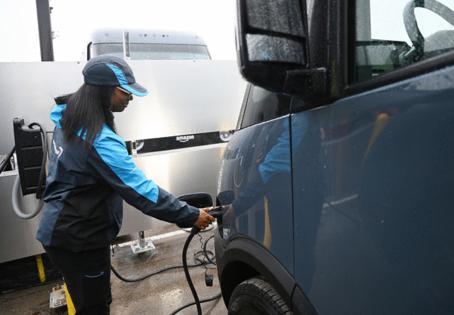How Amazon became the largest private EV charging operator in the US
Published in Business News
Amazon’s Maple Valley, Washington, warehouse is built for speed. At night, big rigs pull up to one end to unload boxes and padded mailers – some after a short drive from a bigger warehouse down the road, others following a flight in the hold of a cargo plane. Waiting employees scan, sort and load them into rolling racks.
Before 7 a.m. each day, many of those racks are wheeled out to dozens of vans lined up in four painted lanes. It’s the starting line at a Formula One race, but for $22-an-hour delivery drivers who ferry bottles of shampoo and packs of batteries to suburban Seattle doorsteps.
Their routes, the last step in a journey that can take products thousands of miles, are the source of a large chunk of the carbon emissions Amazon has pledged to eliminate in the coming decades.
The solution lies in the parking lot across the street: 309 Siemens electric vehicle chargers, which power delivery vans built by Rivian Automotive Inc. Making deliveries without tailpipe emissions, and increasing the size of the electric fleet, is among the most straightforward ways Amazon can wipe carbon from its operations.
In a little more than two years, Amazon has installed more than 17,000 chargers at about 120 warehouses around the US, making the retail giant the largest operator of private electrical vehicle charging infrastructure in the country. “We’ve figured out the path,” said Tom Chempananical, who oversees Amazon’s fleet of last-mile delivery vehicles.
Logistics companies like United Parcel Service Inc. and FedEx Corp. have rolled out their own ambitious electric vehicle targets, though many have failed to meaningfully curb the growing emissions from e-commerce deliveries. Amazon, meanwhile, backed away from a vow to make half of all deliveries with zero carbon pollution by 2030, saying that initiative was superseded by broader climate goals. But the company has come farther and faster in the transition to EVs than most of its competitors. Understanding the challenges faced by Amazon, a company known for going to extreme lengths to meet tight delivery deadlines, can help chart a roadmap for other companies across industries trying to eliminate their own carbon bills.
“Amazon’s scale matters,” said Kellen Schefter, director of transportation at the Edison Electric Institute, a trade group for investor-owned utilities that has worked to connect Amazon to power companies. “If Amazon can show that it meets their climate goals while also meeting their package-delivery goals, we can show this all actually works.”
Amazon has a long way to go. The Seattle-based company says its operations emitted about 71 million metric tons of carbon dioxide equivalent in 2022, up by almost 40% since Jeff Bezos’s 2019 vow that his company would eventually stop contributing to the emissions warming the planet. Many of Amazon’s emissions come from activities – air freight, ocean shipping, construction, and electronics manufacturing, to name a few – that lack a clear, carbon-free alternative, today or any time soon. The company has not made much progress on decarbonization of long-haul trucking, whose emissions tend to be concentrated in industrial and outlying areas rather than the big cities that served as the backdrop for Amazon’s electric delivery vehicle rollout.
But Amazon is on track to purchase by next year as much electricity produced by solar, wind and other carbon-free sources as it uses to power its operations. And in Rivian, which Amazon has backed with a massive investment and an order for 100,000 custom-built delivery vans – 13,500 of which have been delivered to date – the company has suggested it can eliminate much of the emissions associated with its last-mile delivery business.
To get there, Amazon had to learn how to pick up the phone and call the power company. Electric utilities, which to that point primarily dealt with electric vehicles through powering the odd home car charging setup, encountered a new type of customer in Amazon. Government electricity use estimates show a 100,000-square-foot warehouse tucked in an industrial area might be powered by about 50 kilowatts, mainly for lighting and air circulation. Setting up 100 chargers in the parking lot could require 10 to 20 times as much power.
...continued
©2024 Bloomberg L.P. Visit bloomberg.com. Distributed by Tribune Content Agency, LLC.







Comments